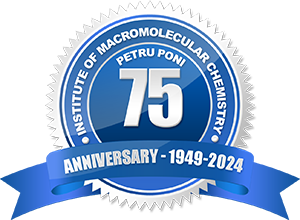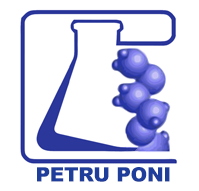Stage 1: 27.06-31.12.2022
Synthesis and characterization of different classes of metal oxide nanoparticles
The goal of the NanoClean project is to synthesize and evaluate the disinfectant activity of metal oxide nanoparticles on the duodenoscope in order to improve the quality of medical care in this sector.
A1.1. Synthesis and characterization of MeO-NPs: Fe3O4, CeO2, TiO2, ZnO2, Ga2O3, MgO and Ag2O (M1-M6)
Within activity A1.1, there were synthesized simple metal oxide nanoparticles, namely: Fe2O3, CeO2, TiO2, ZnO2, Ga2O3, MgO and Ag2O, by using previously reported methods with some modifications. Due to the colloidal instability of some of the synthesized nanoparticles, it was necessary to stabilize them by coating with polymers. Thus, the Fe3O4 nanoparticles, which show a strong tendency to agglomerate due to their magnetic properties, were coated with polyethylene imine (PEI), resulting in nanoparticles with good colloidal stability. Also in case of CeO2 nanoparticles, due to colloidal instability, it was decided to cover them with PEI. However, in order to obtain a good colloidal stability, it was necessary to crosslink the PEI coating of the CeO2 nanoparticles with glutaraldehyde (GA) followed by the inactivation of the aldehyde groups of the unreacted GA, thus obtaining stable nanoparticles with small sizes. Due to the specific instability of these types of oxides, zinc peroxide (ZnO2) and silver oxide (Ag2O) nanoparticles were coated with alginic acid (Alg) and sodium citrate (Cit). Nanoparticles of titanium (TiO2), gallium (Ga2O3) and magnesium (MgO) oxides were not stabilised by coating with polymers.
For all types of synthesized metal oxide nanoparticles, their structures were confirmed using different structural characterization techniques, such as FTIR, DRX, XPS or Raman, depending on particularities of each type of metal oxide. Also, the nanoparticles were characterized in terms of morphology, dimensions, and stability using TEM and DLS techniques. From these studies, it was observed that all the synthesized nanoparticles show a tendency to agglomerate in an aqueous medium. This aggregation tendency was reduced by covering the nanoparticles with a polymer, thus obtaining nanoparticles with smaller sizes and good colloidal stability.
A1.2. Synthesis and characterization of mixed MeO-NPs: Fe3O4 - CeO2, TiO2 – CeO2, CeO2 – ZnO2 (M4-M6)
As part of activity A1.2, there were synthetized hybrid metal oxide nanoparticles Fe3O4- CeO2, using the precursors previously synthesized during activity A1.1, namely Fe3O4-PEI and CeO2-PEI-GA-PEI. To confirm the structure of Fe3O4-CeO2-PEI hybrid nanoparticles, characterization techniques such as FTIR, Raman and EDX were used, observing that the spectrum of hybrid nanoparticles simultaneously presents all the signals characteristic of both precursors, thus confirming the formation of mixed metal oxide nanoparticles. In this case, a morphological and dimensional characterization was performed. From the performed TEM and DLS analyses, it can be observed that the simple metal oxides were conjugated in spherical matrices of the polymer shell of PEI crosslinked with GA.
A1.3. In vitro screening of MeO-NPs antimicrobial activity and cytotoxicity (M2-M6)
Within activity A1.3. the antimicrobial activity and biocompatibility of the synthesized metal oxide nanoparticles were evaluated. Ag2O and ZnO2 nanoparticles have the best antibacterial activity, destroying in 40 minutes all the cells of K. pneumoniae, S. typhimurium and E. faecalis, bacterial strains with a high incidence in nosocomial infections caused by the use of duodenoscopes at the global level. At the same time, these nanoparticles prove that any traces of the compound left on the duodenoscope after high-grade disinfection would not cause the mortality of normal gingival fibroblasts or normal human dermal fibroblasts, thus being biocompatible.
Stage 2: 01.01.-31.12.2023
In vitro evaluation of metal oxide nanoparticles antimicrobial and disinfectant properties
A2.1. Synthesis and characterization of mixed metal oxide nanoparticles (M7–M9)
Activity A2.1 included the syntheses and characterization of mixed metal oxide nanoparticles, such as cobalt-doped iron oxide and calcium peroxide-coated iron oxide nanoparticles. The motivation for choosing these systems was to synthesize magnetic nanoparticles that can be recovered after disinfection and that have antimicrobial properties associated with cobalt oxide and calcium peroxide. Mixed iron-cobalt oxide nanoparticles were synthesized without being coated with polymers to maximise the antimicrobial effect characteristic of the oxide surface. On the other hand, iron oxide nanoparticles coated with calcium peroxide imposed the coating of iron oxide core with sodium alginate, which constituted the complexing agent, facilitating the concentration of calcium ions on the surface of the iron oxide core and chemically stabilizing the peroxide at the same time.
A2.2. Synthesis and characterization of metal oxide nanoparticles loaded with active compounds (M7–M12)
Within the activity A2.2 magnetic nanoparticles loaded with bioactive compounds were synthesized, based on mixtures of antioxidant (protocatechuic acid) and antibiotics (ceftazidime or levofloxacin), as well as zinc oxide nanoparticles embedded in chitosan cross-linked with boronic acids with antimicrobial properties. For all types of synthesized metal oxides, their structures were confirmed using different structural characterization techniques, such as FTIR, EDAX or DRX, depending on the needs and particularities of each analysed sample. Also, the nanoparticles were characterized morphologically and dimensionally using SEM, TEM and DLS techniques, as appropriate. The oxidizing activity of calcium peroxide-based products and protocatechuic acid-based products was studied using UV-Vis spectrophotometric techniques and RES spectroscopy.
A2.3. In vitro screening of metal oxide nanoparticles antimicrobial activity and cytotoxicity (M7–M12)
The antimicrobial activity and cytotoxicity of previously synthesized nanoparticles were evaluated in vitro in Activity A2.3., proving that iron oxide nanoparticles coated with dextran and loaded with protocatechuic acid and antibiotics: ceftazidime or levofloxacin show good compatibility with normal human dermal fibroblasts and high antibacterial activity against S. aureus and E. coli species. Also, zinc oxide-based compounds embedded in chitosan cross-linked with boronic acid have shown remarkable antimicrobial activity against E. faecalis, K. pneumoniae and C. albicans species.
A.2.4. Evaluation of metal oxide nanoparticles disinfectant properties in biomimetic conditions (M13–M18)
Within Activity A2.4, the disinfectant properties of dextran-coated metal oxide nanoparticles loaded with protocatechuic acid and levofloxacin under biomimetic conditions were evaluated on a reference duodenoscope originating from a gastroenterology centre, which was used for various ERCP (endoscopic retrograde cholangiopancreatography). By using these nanoparticles, a high-level disinfection was achieved after 30 minutes of contact, eradicating bacterial species that cause nosocomial infections and resistant biofilms.
A.2.5. Evaluation of metal oxide nanoparticles compatibility with the duodenoscope surfaces (M13-M18)
A challenge test was conducted by immersing the duodenoscope samples in a suspension of metal oxide nanoparticles loaded with protocatechuic acid and levofloxacin for 30 minutes daily for 45 consecutive days. AFM and SEM were used to prove that repeated treatment of duodenoscope coating polymer samples did not result in significant differences in morphological surface between the treated and untreated samples.
A2.6. Evaluation of metal oxide nanoparticles compatibility with duodenoscope polymer coatings (M13-M18)
The antimicrobial adherence properties of the duodenoscope samples were investigated after the decontamination with metal oxide nanoparticles loaded with protocatechuic acid and levofloxacin, proving that the nanoparticles don’t modify the antimicrobial properties of the duodenoscope coatings, not allowing bacterial adhesion and growth, and most of all, not allowing biofilm formation.
Stage 3: 01.01.-26.06.2024
Evaluation of the metal oxide nanoparticles compatibility with the duodenoscope surfaces
A3.1. Evaluation of metal oxide nanoparticles disinfectant properties in biomimetic conditions (M19-M22)
There were evaluated CaO2-Alg NPs disinfectant properties under biomimetic conditions on a reference duodenoscope achieving a high-level disinfection by eradicating bacterial species that cause nosocomial infections and resistant biofilms after only 20 minutes of contact.
A3.2. Evaluation of metal oxide nanoparticles compatibility with the duodenoscope surfaces (M19-M23)
The impact of repeated exposure to CaO2-Alg nanoparticles on the polymer samples of the duodenoscope was evaluated, through repeated exposure for 45 days, proving through techniques such as AFM, SEM, FTIR and DSC that these compounds do not cause additional damage to the outer polymer coating of the duodenoscope.
A3.3. Evaluation of microbial adhesion on the surface of the duodenoscope following prolonged contact with metal oxide nanoparticles (M19-M23)
The antimicrobial adherence properties of the duodenoscope samples were investigated after the decontamination with CaO2-Alg NPs, proving that the nanoparticles are not allowing the bacterial adhesion and biofilm formation.
| 







